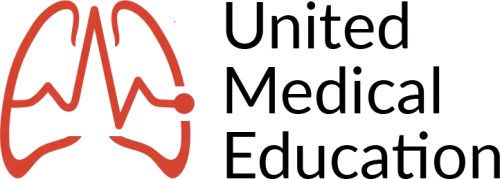Welcome to the medication guide here at United Medical Education. Here we discuss drug therapies used during cardiopulmonary emergencies for patients of all age groups.
Adjunct Medications
Adenosine
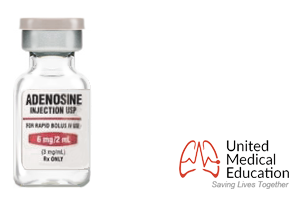
Adenosine is one of the most commonly used medications in the ACLS and PALS algorithms. It is an antiarrhythmic medication used to treat various forms of supraventricular tachycardia after vegal maneuvers have failed. The delivery of adenosine in ACLS and PALS causes a transient heart block in the atrioventricular (AV) node. This is due to α1 receptor inhibition of adenylyl cyclase. As a result there is a reduction of cAMP that leads to the hyperpolarization of the cells. It also causes the relaxation of smooth muscle found on the inner arterial walls, resulting in arterial dilation. Part of the problem with Adenosine is it reduces blood perfusion past the arterial occlusions resulting in less oxygen delivery to the ischemic areas.
Medical Uses:
Antiarrhythmic agent:
Specific supraventricular tachycardia’s (SVT’s) can often be eliminated with the use of adenosine. Specifically AV reentrant tachycardia (AVRT) and also the AV nodal reentrant tachycardia (AVNRT) arrhythmias. It should be noted that atrial tachycardia has also been known to be treated successfully by adenosine. Tachycardia’s that are confined solely to the atria or ventricle and do not have any reentry circuit involvement with regards to the AV node generally to not convert with the use of this medication. Regardless, the ventricular rate can often still be minimized after its administration.
Diagnosis of Supraventricular Tachycardia:
Because adenosine causes an exaggerated difference between the perfused and non-perfused arterial branches of the heart, it is commonly used to identify blockages. It also can help identify and eliminate certain supraventricular tachycardias (SVT’s).
Nuclear stress test:
For patients who are unable to undergo a traditional nuclear stress test using exercise, adenosine is used to simulate stress on the heart and differentiate between perfused and non-perfused areas.
Indications in ACLS and PALS:
- Stable Supraventricular tachycardia
- Ventricular tachycardia (monomorphic)
Adverse Reactions:
- Chest pain
- Shortness of breath
- Feeling faint
- Worsening dysrhythmia
- Lowering blood pressure
- Diaphoresis
- Nausea
- Metallic taste in mouth
- Facial flushing
Contraindications:
- Second degree heart block
- Third degree heart block
- Sick sinus syndrome
- Long QT interval
- Polymorphic wide-complex tachycardia
- Unstable VT
Routes:
- Intravenous
- Intraosseous
Avoid administration via a central catheter due to adenosines affect on the arterial tissue to spontaneously initiate atrial fibrillation. This can lead to ventricular fibrillation in patients that have an accessory pathway.
Dose and Administration:
Doses should be administered and followed with a rapid flush as fast as possible.
Adults ACLS:
1st dose: Give 6mg IV/IO over 1-3 seconds, immediately followed by 20ml of NS by rapid IV/IO.
2nd dose: If the patient still has an SVT rhythm 1-2 minutes later give 12mg IV/IO over 1-3 seconds, immediately followed by 20ml of NS by rapid IVP/IO.
Consider a lower dose of 3mg for patients that:
- Take carbamazepine
- Take dipyridamole
- Have a history of heart transplant
- Administration by central line
Pediatrics PALS:
1st dose: Give 0.1mg/kg by IV/IO over 1-3 seconds with a maximum dose of 6mg.
2nd dose: Give 0.2mg/kg by IV/IO over 1-3 seconds with a maximum dose of 12mg.
Doses should be administered and followed with a rapid flush as fast as possible.
Amiodarone

Amiodarone is an effective antiarrhythmic class 3 drug commonly used during ACLS and PALS. It was first created in 1962 to treat heart related chest pain, and later removed from the general market due to side effects in 1967. In 1974 the drug was reintroduced to the market after its ability to treat arrhythmias during emergency cardiac events and its ability to prevent life-threatening arrhythmias in high-risk individuals were discovered. As an antiarrhythmic it works on the myocardium by delaying repolarization and increasing the duration of the action potential. Today it is considered one of the most effective and safe medications of its kind in the healthcare system and as a result has been placed on the Essential Medicines list by the World Health Organization (WHO).
Medical Uses:
Amiodarone is most commonly used to treat arrhythmias during emergency cardiac events. It is also commonly proscribed and used to prevent life-threatening cardiac arrhythmias in patients that have a chronic risk of developing such arrhythmias.
Cardiac Arrest:
While the first line treatment for cardiac arrest resulting from ventricular fibrillation and ventricular tachycardia is defibrillation, amiodarone has been used as a second line drug therapy, after epinephrine, to treat shock-refractory ventricular fibrillation. It should be noted that after a review made of the drug in 2016, there was no improvement of positive outcomes and/or survival in patients who received amiodarone after they had experienced cardiac arrest.
Stable Ventricular Tachycardia (Monomorphic):
Amiodarone can be used in cases of stable ventricular tachycardia. It should be noted that amiodarone is contraindicated in individuals with ventricular tachycardia (polymorphic) due to the prolonged QT interval.
Atrial Fibrillation:
The benefit of using amiodarone in the critically ill population who are experiencing acute onset atrial fibrillation has yet to be determined.
Indications in ACLS and PALS:
Initiate the use of Amiodarone only after the first line treatments (defibrillation/cardioversion and epinephrine) have failed to treat:
- Ventricular Tachycardia (VT)
- Ventricular Fibrillation (VF)
- Stable Supraventricular Tachycardia
Adverse Reactions:
Amiodarone has a long list of adverse reactions that are generally experienced only by those who chronically take the medication. These include:
- Burning at the IV site
- Bradycardia
- Hypotension
- Interstitial lung disease (pulmonary fibrosis)
- Hypothyroidism (Wolff-Chaikoff effect)
- Hyperthyroidism (Jod-Basedow effect)
- Corneal micro-deposits
- Optic neuropathy
- Bilateral optic disc swelling
- Reversible visual field defects
- Liver enzyme changes
- Jaundice
- Hepatomegaly
- Hepatitis
- Cirrhosis
- Skin sensitivity to light
- Peripheral neuropathy
- Epididymitis
- Gynecomastia
- Increased risk of cancer
Contraindications:
- Sick Sinus Syndrome
- Prolonged QT interval
- 2nd Degree Heart Block
- 3rd Degree Heart Block
- Cardiogenic shock
- Heart block
- Symptomatic bradycardia
- Sensitivity to iodine and benzyl alcohol
Routes:
In ACLS and PALS two routes are used for administration:
- Intravenouse
- Intraosseous
Chronic use of the drug for prevention of arrhythmias is usually taken by mouth. It can take several weeks for the drug to take effect when taken by mouth.
Dose and Administration:
For Stable Wide-QRS tachycardia with a pulse:
Adult ACLS:
Give 150mg by IV over 10 minutes. If the arrhythmia persists or returns you may repeat the bolus. Follow with a maintenance infusion of 1mg/min for 6 hours with a maximum dose of 2.2g given in a 24 hour period.
Pediatric PALS:
Give 5mg/kg IV/IO over 20-60 minutes (single dose not exceeding 300mg). You may repeat this dose 2 times with a max combined dosing not to exceed 15mg/kg in 24 hours.
For Ventricular Fibrillation and Ventricular Tachycardia without a pulse:
Adult ACLS:
Give Amiodarone 300mg IV/IO push. If the arrhythmia persists or returns you may give one additional bolus of 150mg IV/IO push 3-5 minutes after the initial dose. After conversion of the arrhythmia an amiodarone infusion can be given at a rate of 1mg/min over 6 hours and then a 0.5mg/min infusion over 18 hours.
Pediatric PALS:
Give 5mg/kg IV/IO push (single dose not exceeding 300mg). You may repeat the bolus up to 2 times with a max combined dosing not to exceed 15mg/kg in 24 hours.
Amiodarone should be given using an in-line filter and diluted only using D5W.
Atropine

Atropine is an antimuscarinic (anticholinergic) medication that inhibits the parasympathetic nervous system. It does this by antagonizing the muscarine-like action of choline esters such as acetylcholine. It was first discovered in 1833 and has been placed the list of essential medicines by the World Health Organization (WHO).
Medical Uses:
Heart:
Atropine is commonly used as a treatment for bradycardia (HR<60bpm). It was previously used in the ACLS algorithm for cardiac arrest, asystole, and PEA but had later been removed to treat these arrhythmias because of lack of evidence showing that it was effective in converting the rhythms. Atropine has proven effective in treating the arrhythmia second-degree heart block Mobitz type 1. It has also been effective against third-degree heart block but only in those with an AV-node escape rhythm. Atropine has also been known to treat a bradycardic response to intubation in children.
Eyes:
Atropine is commonly used topically as a cycloplegic which temporarily paralyzes the accommodation reflex of the eye. It is also used as a mydriatic to dialate the pupils.
Secretions:
Atropine causes the inhibition of the salivary and mucous glands through its parasympathetic activity. It has also been used to inhibit sweating.
Poisoning:
Atropine has been used as a treatment for poisoning caused by organophosphate insecticides and nerve gases. Some of these poisons to which it is well suited to prevent poisoning include sarin, soman, and tabun. Atropine blocks the muscarinic acetylcholine receptors, preventing them from being overstimulated by the accumulation of acetylcholine caused by the poisoning agent.
Indications in ACLS and PALS:
- Symptomatic Bradycardia
Adverse Reactions:
- Dry mouth
- Urinary retention
- Large pupils
Contraindications:
It should generally be avoided in patients with angle closure glaucoma.
Routes:
- Intravenous
- intraosseous
Dose and Administration:
Adult ACLS:
Give Atropine 0.5mg IV/IO. You may repeat this every 3 to 5 minutes with a maximum dose of 3mg (6 doses).
Pediatric PALS:
Give atropine 0.02mg/kg IV/IO. You may repeat this once with an overall minimum dose of 0.1mg and a maximum dose of 0.5mg.
Diltiazem
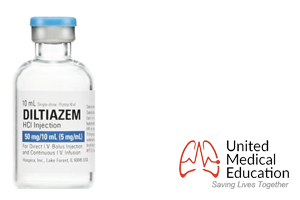
Diltiazem is a benzothiazepine calcium channel blocker that acts both as a cardiac depressant through A-V node conduction depression, and vasodilator. As a result Diltiazem is able to lower arterial pressure without causing significant reflex cardiac stimulation.
Medical Uses:
Antihypertensive:
Diltiazem is primarily used to lower the blood pressure in hypertensive patients. It relaxes the smooth muscle in arterial walls causing vasodilation. It also lowers blood pressure by reducing the contraction force of the heart, reducing it’s rate of contraction and slowing the speed of electrical conduction in the heart.
Antiarrhythmic:
Diltiazem is used to lower the heart rate, contractility, and to slow the speed of electrical conduction in the heart in individuals experiencing narrow complex tachycardia.
Angina Pectoris:
Due to the negative inotropic, chronotropic and dromotropic effects of Diltiazem there is a reduced level of oxygen consumption by the heart and a reduction in anginal type symptoms.
Indications in ACLS and PALS:
- Narrow complex tachycardia
Adverse Reactions:
- Headache
- Dizziness
- Weakness
- Lethargy
- Nausea
- Sore throat
- Cough
- Stuffy nose
- Fainting
- Bradycardia
- Irregular heart beat
- Shortness of breath
- Edema
Contraindications:
- Severe congestive heart failure
- SA node disturbances
- AV node disturbances
- Hypotension presenting with systolic blood pressure below 90mmHg
- Wolff-parkinson-white
- Sick sinus syndrome
- Bradycardia
- Peripheral artery occlusive disease
- COPD
Routes:
- Intravenous
- Intraosseous
- Oral
Dose and Administration:
Adult ACLS:
The dose of Diltiazem may vary depending on the patient’s symptoms, medical history, and physician orders. However, standard general doses are the following:
1st dose: Give 0.25mg/kg (between 10-20mg) IV/IO over 2 minutes.
2nd dose: Give 0.35mg/kg (between 20-25mg) IV/IO over 2 minutes.
Common subsequent infusion: Give 5-20mg/hr IV/IO infusion.
Pediatric PALS:
Currently not in the PALS algorithms
Dopamine

Dopamine is a chemical precursor to norepinephrine with effects similar to other catecholamine agents. It is a chemical messenger that stimulates action on both the α and β receptors and also stimulates the action of the dopaminergic receptors DA1 and DA2. The specific effects of dopamine are known to be dose dependant.
At normal concentrations it increases the force of contraction in the heart resulting in an increase in cardiac output (CO) and blood pressure (BP). It also acts as a peripheral vasodilator by inhibiting the release of norepinephrine. Normal doses cause an increase in the excretion of sodium by the kidneys resulting in increased urine output. Higher doses are known to cause vasoconstriction.
Medical Uses:
Heart:
Dopamine is commonly used to treat symptomatic bradycardia or hypotension that occurs following the return of spontaneous circulation (ROSC). Along with other medications, dopamine can be used to manage shock following successful resuscitation.
Indications in ACLS and PALS:
- Symptomatic bradycardia
- Severe hypotension
Adverse Reactions:
- Irregular heart rhythm
- Kidney failure
(Doses above 10μg/kg per minute are known to cause systemic and splanchnic vasoconstriction. Use with caution in higher doses as the decrease in splanchic perfusion may have adverse effects.)
Contraindications:
- Compromised renal function
Routes:
- Intravenous
- intraosseous
Dose and Administration:
Titrate to the patient’s response. Medication changes should be tapered slowly.
Adult ACLS:
Give as an infusion at 5 to 20μg/kg/min IV/IO.
Pediatric PALS:
Give as an infusion at 2 to 20μg/kg/min IV/IO.
Epinephrine (Adrenaline)
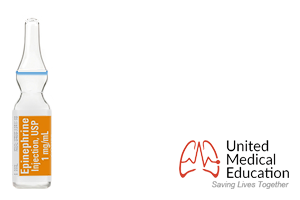
Epinephrine is one of the most common drugs used during emergency treatment when performing ACLS (Advanced Cardiac Life Support) and PALS (Pediatric Advanced Life Support). It is used during ACLS and PALS because it has a wide range of indications. These include the treatment of cardiac arrest, arrhythmias, and extreme allergic reactions such as anaphylaxis.
Epinephrine is a catecholamine having a non-specific action on the adrenoceptors causing an increase in activation of the sympathetic nervous system. Levels of epinephrine can be found endogenously in the body in the adrenal gland. The adrenal gland releases epinephrine in response to stress. The activation of the sympathetic nervous system is commonly referred to as the fight-or-flight response. Epinephrine primarily affects metabolic responses.
Medical Uses:
Cardiac:
Medical uses for this drug include the treatment of cardiac arrest and arrhythmias. It primarily increases peripheral vascular resistance or vasoconstriction through the activation of α1 receptors and increases cardiac output through the activation of β1 receptors. This leads to the end result of reduced perfusion of the peripheral extremities in exchange for increased cardiac and cerebral perfusion pressure.
Allergies/Anaphylaxis:
Epinephrine (adrenaline) is also commonly used to treat anaphylactic shock. The primary goal is to reduce the inflammatory response associated with an allergic reaction. In other words to reduce vasodilation caused by the allergic reaction through the stimulation of beta and alpha receptors. This will cause a reduction of fluid leaking through the post capillary venules.
Respiratory:
While this medication is no longer used regularly as a first line treatment for asthma it can still provide benefits. It acts as a bronchodilator by activating β2 receptors. Generally the medication is used if other β2 agonists were ineffective or unavailable for treatment.
Local Anesthetics:
Epinephrine is used to prolong the affects of local anesthetics by slowing the rate of tissue absorption. This is done through vasoconstriction of local capillaries through the activation of local receptors. Because of the reduced blood flow associated with local epinephrine administration, certain parts of the body should not be injected. These include distal extremities, genitals, and parts of the face.
Indications in ACLS and PALS:
- Pulseless Ventricular Tachycardia (pVT)
- Ventricular Fibrillation (VF)
- Asystole
- Pulseless Electrical Activity (PEA)
- Bradycardia
Adverse Reactions:
Because of the systemic effects of epinephrine some patients may experience certain unwanted or adverse symptoms associated with its administration. Some of these adverse reactions include:
- Anxiety
- Headache
- increased blood pressure
- tachycardia
- arrhythmias
Most adverse reactions are dose dependant. Some feel that the administration of epinephrine has not proven to improve the long-term survival of critically ill patients during cardiac arrest. However, it remains one of the most commonly used medications in the treatment of cardiac arrest and other arrhythmias during ACLS and PALS administration.
Contraindications:
It should generally be avoided in patients with angle closure glaucoma.
Routes:
In the ACLS and PALS algorithms three routes can be used for delivery of epinephrine.
- Intravenous
- Intraosseous
- Endotracheal tube
Dose and Administration:
For pVT, VF, Asystole, and PEA:
Adult ACLS:
Give 1mg IV/IO every 3-5 minutes (or give 2mg in 10ml of NS by ETT).
Pediatric PALS:
Give Epinephrin in a 1:10,000 solution: 0.01 mg/kg by IV/IO every 3 to 5 minutes (or give Epinephrine in a 1:1,000 solution: 0.1 mg/kg by ETT).
For Bradycardia:
Adult ACLS:
Start an infusion with a dose of 2-10 mcg/min IV/IO titrating to the patient’s response.
Pediatric PALS:
Give Epinephrine in a 1:10,000 solution: 0.01 mg/kg by IV/IO every 3 to 5 minutes (or give Epinephrine in a 1:1,000 solution: 0.1 mg/kg by ETT).
Lidocaine

Lidocaine is a fast sodium channel blocker, class-1b antiarrhythmic which can be used to reduce the frequency by which the heart contracts. It is known to selectively depress phase 0 in ischemic and abnormal tissue. It also shortens the repolarization phase of the cell. Lidocaine is also considered an amide-type local anesthetic agent. It was discovered in 1948 and was later placed on the list of essential medicines by the World Health Organization (WHO).
Medical Uses:
Heart:
Lidocaine qualifies as an antiarrhythmic sodium channel blocker class 1B drug. It preferentially binds to inactivated Na+ channels on the cell wall. The routine use of the medication as an antiarrhythic agent is not recommended. However, if there is a return of spontaneous curculation (ROSC) in a patient lidocaine administration may be considered.
Anesthetic:
Lidocaine is commonly used as an anesthetic. It helps prevent the repolarization of surrounding neurons thus preventing them from signaling the brain. As an anesthetic it is used to both perform nerve blocks and to numb pain in localized tissue.
Indications in ACLS and PALS:
Adult ACLS:
- 2nd line agent if amiodarone is unavailable
- Refractory Ventricular fibrillation (VF)
- Pulseless ventricular tachycardia (pVT)
- Continuous infusion after return of spontaneous circulation (ROSC) from VF/pVT
Pediatric PALS:
- Shock-refractory ventricular fibrillation (VF)
- Pulseless ventricular tachycardia (pVT)
Adverse Reactions:
- Bradycardia
- Muscle twitching
- Sleepiness
- changes in vision
- tingling
- confusion
- vomiting
- hypotension
- irregular hear beat
Contraindications:
- Bradycardia
- Second degree heart block
- Third degree heart block
- Severe sinoatrial block
- Accelerated idioventricular arrhythmia
- Adam-Stokes syndrome
- Wolff-Parkinson-White syndrome
- Prior amiodarone administration
- Concurrent administration with a type 1 antiarrhythmic (ie procainamide)
- Pseudocholinesterase deficiency
- Impaired liver function
Routes:
In the ACLS and PALS algorithms two routes can be used for delivery.
- Intravenous
- Intraosseous
Routes for other uses include:
- Transdermal
- Subcutaneous
- Topical
- Aerosol
Dose and Administration:
Adult ACLS:
1st dose: give 1-1.5mg/kg IV/IO every 5 to 10 minutes.
Repeat doses: 0.5-0.75mg/kg IV/IO every 5 to 10 minutes with a total maximum loading dose of 3mg/kg.
Continuous infusion dose for post return of spontaneous circulation from VF/pVT:
Give lidocaine at 1-4mg/min continuous infusion.
Pediatric PALS:
Dose: Give 1mg/kg IV/IO bolus.
Continuous infusion dose for post return of spontaneous circulation from VF/pVT:
Give a lidocaine infusion of 20-50mcg/kg/min.
Magnesium
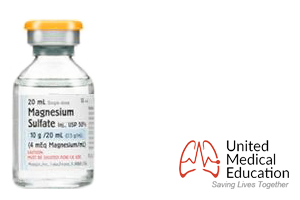
Magnesium is an element critical to proper bodily function. Magnesium given either by the intravenous or intramuscular routes is usually in the form of magnesium sulfate solution and is entirely bioavailable. Magnesium is known to directly inhibit action potentials of the myometrial muscle cells. As a result both the excitation and the contraction of the cells is uncoupled. This leads to both a decrease in force and frequency of contraction in the myocardial cells.
Medical Uses:
Heart:
Magnesium is often used as an antiarrhythmic agent in the treatment of torsades de pointes during cardiac arrest. It is also used in patients suffering from arrhythmias related to hypomagnesemia and to treat digitalis toxicity.
Respiratory:
During severe asthma attacks, magnesium can be used as a bronchodilator if anticholinergic drugs and beta-agonists have failed. It is most commonly given intravenously to treat asthma but recent studies have shown it is effective when delivered as a nebulized drug as well.
Vascular:
Magnesium is regularly used to treat eclampsia. It primarily acts as a vasodilator in both the peripheral vasculature and cerebral vasculature resulting in a decrease in vascular resistance.
Indications in ACLS and PALS:
Magnesium is primarily used to treat torsades de pointes (polymorphic VT associated with a prolonged QT interval), hypomagnesemia, and digitalis toxicity.
Adverse Reactions:
- Calcium deficiency
- Upset stomach
- Diarrhea
- Nausea
- Vomiting
- Lowered blood pressure
- Decreased heart rate
- Respiratory paralysis
- Confusion
- Cardiac arrhythmias
- Coma
- Cardiac arrest
Contraindications:
- Hypermagnesemia
- Hypocalcemia (May result in respiratory distress)
Magnesium should be used with caution in patients that have a history or renal failure.
Routes:
In the ACLS and PALS algorithms two routes can be used for delivery:
- Intravenous
- Intraosseous
Routes for other uses include:
- Intramuscular
- Aerosol
Dose and Administration:
Torsades de Pointes
Adult ACLS:
With a pulse: Give 1-2g slow IV/IO infusion over 5-60 minutes, followed with a maintenance infusion of 0.5-1g/hr. (Magnesium should be diluted in 50-100ml of D5W.)
Cardiac arrest: Give 1-2gm slow IV/IO infusion over 5-20 minutes. (Magnesium should be diluted in 50-100ml of D5W.)
In instances of severe renal impairment do not give more than 20g in 48 hours.
Pediatric PALS:
Give 25-50mg/kg IV/IO over 15-30 minutes with a max dose of 2g. (Magnesium should be diluted in 10mg/ml of D5W.)
Naloxone (Narcan)
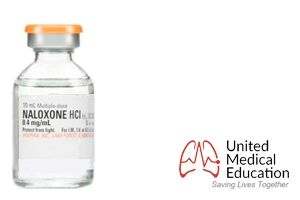
Naloxone is a competitive non-selective opioid receptor antagonist. It primarily binds to the μ-opioid receptors, followed by the δ-opioid receptors, and then having the lowest affinity for the κ-opioid receptors. If naloxone is administered in the absence of opioid medications in the body there is no significant pharmacological action, apart from preventing the body from being able to manage pain naturally by blocking pain-lowering endorphins for a brief period of time. If given by IV, it only takes 2 minutes for naloxone to start taking effect. However, it’s mean serum half-life is often much shorter than many prescription opioid medications, ranging only between 30-81 minutes. As a result multiple periodic doses may be required to treat opioid induced medical emergencies.
Medical Uses:
Naloxone is generally used to block the effects of opioid medications, especially during accidental overdose by those suffering from addiction.
Indications in ACLS, PALS and BLS:
Indications include use in patients with a history of known or suspected opioid use/abuse who are likely showing signs of overdose. These are patients who are unresponsive, have a pulse, and are not breathing or are presenting with abnormal breathing (ie respiratory arrest or gasping).
Adverse Reactions:
There are few to no effects in people without opioids in their system.
In people with opioids in their system:
- Headache
- Agitation
- Flushing
- Sweating
- Nausea
- Vomiting
- Restlessness
- Trembling
- Body pain
- Hypertension
- Hypotension
- Pulmonary edema
- Seizures
- Brain disease
- Coma
- Changes in heart rhythm
Contraindications:
- Hypersensitivity to naloxone
- Hypersensitivity to naloxone’s formulary components
- Routes:
- Intravenous
- Intraosseous
- intramuscular
- Intranasal
Routes:
- Intravenous
- Intraosseous
- Intramuscular
- intranasal
Dose and Administration:
Adult ACLS and BLS:
Give 0.4mg IV/IO/IM or 2mg IN. Repeat in 4 minutes if necessary.
Pediatric PALS:
For children ≤ 5 years or ≤ 20kg: Give 0.1mg/kg IV/IO/IM/SC/ET. Not to exceed 2mg/dose.
Give repeated doses every 2-3 minutes as needed until complete reversal of the opioid effect.
For children > 5 years of age or > 20kg: Give 2mg IV/IO/IM/SC/ET per dose.
Procainamide
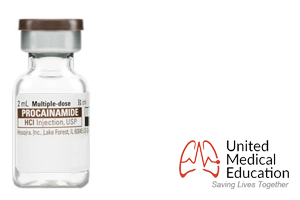
Procainamide is a sodium (Na+) channel blocker that is labeled as a class 1a antiarrhythmic agent. It specifically blocks the sodium channels of cardiomyocytes and inhibits the potassium (K+) rectifier current.
Medical Uses:
Heart:
Procainamide is used to treat supraventricular arrhythmias such as atrial fibrillation, automatic supraventricular tachycardia, and re-entrant supraventricular tachycardia.
Indications in ACLS and PALS:
- Ventricular tachycardia with a pulse
- Supraventricular tachycardia
- Atrial fibrillation
- Atrial flutter
Adverse Reactions:
- Ventricular dysrhythmia
- Bradycardia
- Hypotention
- Shock
- Flushing
- Angioedema
- uticaria
- pleurisy
- Polyarthralgia
- myalgia
- Systemic lupus erythematosus (SLE)
- Drug fever
Contraindications:
- History of QT prolongation
- 2nd and 3rd degree AV block
- Torsades de pointes
- Electrolyte abnormalities
- Congestive heart failure (CHF)
- Systemic lupus erythematosus (SLE)
- Myasthenia gravis
- Severe renal impairment
- Bone marrow depression
- Symptomatic bradycardias
Routes:
- Intravenous
- intraosseous
Dose and Administration:
Adult ACLS:
Give as an infusion at 20-50mg/min IV/IO (maximum dose of 17mg/kg).
Continue the infusion until the rhythm converts, hypotension occurs, or the QRS complex duration rises over 50%.
You may also give a maintenance infusion rate at 1-4mg/min IV/IO.
Pediatric PALS:
Give infusion of 15mg/kg IV/IO in 30-60 minutes.
Sotalol

Sotalol is a non-selective beta blocker that also includes class III antiarrhythmic activity. It prolongs the refractory period and increases the action potential duration of the cardiac muscle. Sotalol is only recommended by the Food and Drug Administration (FDA) for serious life threatening arrhythmias because of its potential to develop a prolongation in the QT interval which increases the risk of torsades de point development.
Medical Uses:
Heart:
Sotalol is used to maintain normal heart function and rhythm in individuals that exhibit serious ventricular arrhythmias, symptomatic atrial fibrillation and symptomatic atrial flutter. Due to it’s high risk profile it is only to be used if vegal maneuvers and other simple rhythm converting methods were unsuccessful.
Indications in ACLS:
- Life-threatening ventricular arrhythmias
Adverse Reactions:
- Prolonged QT interval (potential for torsades de point)
- Chest pain
- Shortness of breath
- Bradycardia
- Fatigue
- Dizziness
- Weakness
- Lightheadedness
Contraindications:
- Prolonged QT syndrome
- Asthma
- History of Bronchospastic disease processes
- Waking heart rate below 50bpm
- Sick sinus syndrome
- Uncontrolled heart failure
- Cardiogenic shock
- Potassium (K+) levels under 4meq/L
Routes:
- Intravenous
- Intraosseous
- Oral
Dose and Administration:
Adult ACLS:
Give 100mg (1.5mg/kg) IV/IO over 5 minutes.
Pediatric PALS:
Currently not in the PALS algorithms.
Adjunct Medications
Isoproterenol
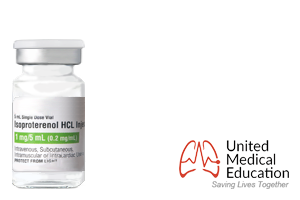
Isoproterenol is a non-selective beta adrenergic agonist (Sympathomimetic) affecting both the β1 and β2 adrenergic receptors. This is achieved partially by the stimulation of beta adrenergic receptors of adenyl cyclase within the cell. Adenyl cyclase is the enzyme known for converting adenosine triphosphate (ATP) into cyclic adenosine monophosphate (cAMP). This generally results in lowering the peripheral vascular resistance in skeletal muscle, renal vascular beds, and also mesenteric vascular beds lowering diastolic pressure. Depending on the dose the systolic blood pressure often remains unchanged causing a widening in pulse pressure and a lowering of mean arterial pressure. Because of the decreased vascular resistance there is generally an increase in cardiac output (CO). Isoproterenol is also known to relax the smooth muscle found in bronchials.
Medical Uses:
Heart:
Isoproterenol may be used in cardiac arrest until defibrillation can be performed, a pacemaker can be placed, or other therapy may be implemented. It is also an optional therapy for serious heart block and Adam-Stokes attack not caused by ventricular tachycardia. It is commonly used for transient episode of heart block that do not necessitate more invasive levels of therapy such as a pacemaker or giving an electric shock.
Lungs:
Isoproterenol may be used to treat bronchospasm in the hospital setting. Most commonly during anesthesia.
Indications in ACLS and PALS:
Isoproteranol is not directly in the ACLS or PALS algorithms. However, experienced medical providers may use it in instances of heart block with a pulse and bradycardia with a pulse when transcutaceous pacing fails or has been delayed.
Adverse Reactions:
- Headache
- Dizziness
- Nervousness
- Angina
- Palpitations
- Tachycardia
- Ventricular arrhythmias
- Adams-Stokes attack
- Hypertension
- Hypotension
- Pulmonary edema
Contraindications:
- Angina pectoris
- Tachyarrhythmias
- Heart block caused by digitalis toxicity
- Ventricular arrhythmias requiring inotropic support
Routes:
- Intravenous
- Intraosseous
- Intramuscular
- Subcutaneous
Dose and Administration:
Adults (Not in ACLS algorithm):
Give as an infusion starting at 5mcg/min then titrate between 2-20mcg/min IV/IO based upon patient’s needs.
Pediatrics (Not in PALS algorithm):
Give as an infusion at 0.05-2mcg/kg/min IV/IO. Start at minimum recommended dose and increase by 0.1mcg/kg/min every 5-10 minutes as needed until max dose is reached.
